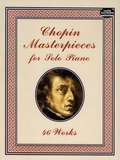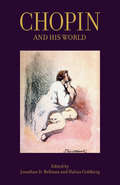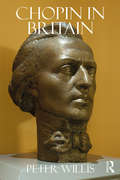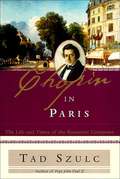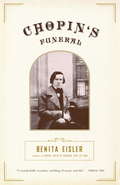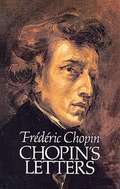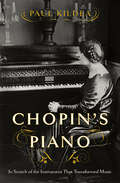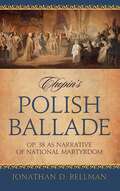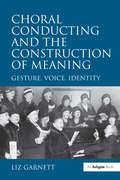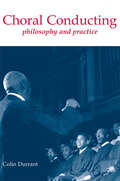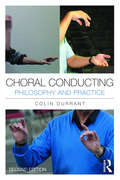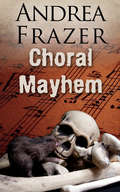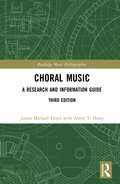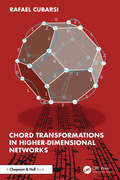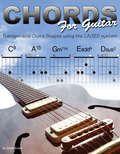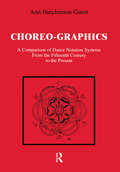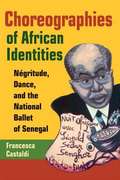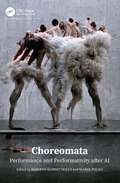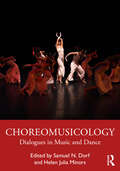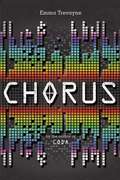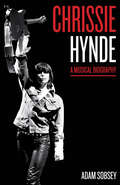- Table View
- List View
Chopin Masterpieces for Solo Piano: 46 Works
by Frédéric ChopinOf all the composers of piano music, it is Chopin whose works are most frequently performed. Musicians and music lovers delight in his lovely melodies, rich harmonies, captivating rhythms, and command of total keyboard sound.This generous collection contains 46 of Chopin's most important and best-loved pieces, edited by Carl Mikuli and based on first-hand knowledge of the master's personal approach to these works. Included are the Ballade No. 1 in G Minor, Berceuse, 3 Ecossaises, 5 Etudes (including the fiery "Revolutionary"), Fantaisie-Impromptu, "Marche Funèbre" from Sonata No. 2, 8 Mazurkas, 7 Nocturnes, 3 Polonaises (including the enormously popular "Militaire"), 9 Preludes, Scherzo No. 2 in B-flat Minor, and 6 Waltzes (including the "Minute Waltz"). Reprinted from authoritative sources, this superb collection brings together a splendid selection of pieces in one convenient, attractive, low-priced volume that will provide lasting enjoyment to a wide range of pianists and music lovers.
Chopin and His World
by Jonathan D. Bellman Halina GoldbergA new look at the life, times, and music of Polish composer and piano virtuoso Fryderyk ChopinFryderyk Chopin (1810–49), although the most beloved of piano composers, remains a contradictory figure, an artist of virtually universal appeal who preferred the company of only a few sympathetic friends and listeners. Chopin and His World reexamines Chopin and his music in light of the cultural narratives formed during his lifetime. These include the romanticism of the ailing spirit, tragically singing its death-song as life ebbs; the Polish expatriate, helpless witness to the martyrdom of his beloved homeland, exiled among friendly but uncomprehending strangers; the sorcerer-bard of dream, memory, and Gothic terror; and the pianist's pianist, shunning the appreciative crowds yet composing and improvising idealized operas, scenes, dances, and narratives in the shadow of virtuoso-idol Franz Liszt. The international Chopin scholars gathered here demonstrate the ways in which Chopin responded to and was understood to exemplify these narratives, as an artist of his own time and one who transcended it. This collection also offers recently rediscovered artistic representations of his hands (with analysis), and—for the first time in English—an extended tribute to Chopin published in Poland upon his death and contemporary Polish writings contextualizing Chopin's compositional strategies. The contributors are Jonathan D. Bellman, Leon Botstein, Jean-Jacques Eigeldinger, Halina Goldberg, Jeffrey Kallberg, David Kasunic, Anatole Leikin, Eric McKee, James Parakilas, John Rink, and Sandra P. Rosenblum. Contemporary documents by Karol Kurpiński, Adam Mickiewicz, and Józef Sikorski are included.
Chopin in Britain
by Peter WillisIn 1848, the penultimate year of his life, Chopin visited England and Scotland at the instigation of his aristocratic Scots pupil, Jane Stirling. In the autumn of that year, he returned to Paris. The following autumn he was dead. Despite the fascination the composer continues to hold for scholars, this brief but important period, and his previous visit to London in 1837, remain little known. In this richly illustrated study, Peter Willis draws on extensive original documentary evidence, as well as cultural artefacts, to tell the story of these two visits and to place them into aristocratic and artistic life in mid-nineteenth-century England and Scotland. In addition to filling a significant hole in our knowledge of the composer’s life, the book adds to our understanding of a number of important figures, including Jane Stirling and the painter Ary Scheffer. The social and artistic milieux of London, Manchester, Glasgow and Edinburgh are brought to vivid life.
Chopin in Paris
by Tad SzulcChopin in Paris introduces the most important musical and literary figures of Fryderyk Chopin's day in a glittering story of the Romantic era. During Chopin's eighteen years in Paris, lasting nearly half his short life, he shone at the center of the immensely talented artists who were defining their time -- Hugo, Balzac, Stendhal, Delacroix, Liszt, Berlioz, and, of course, George Sand, a rebel feminist writer who became Chopin's lover and protector. Tad Szulc, the author of Fidel and Pope John Paul II, approaches his subject with imagination and insight, drawing extensively on diaries, memoirs, correspondence, and the composer's own journal, portions of which appear here for the first time in English. He uses contemporary sources to chronicle Chopin's meteoric rise in his native Poland, an ascent that had brought him to play before the reigning Russian grand duke at the age of eight. He left his homeland when he was eighteen, just before Warsaw's patriotic uprising was crushed by the tsar's armies. Carrying the memories of Poland and its folk music that would later surface in his polonaises and mazurkas, Chopin traveled to Vienna. There he established his reputation in the most demanding city of Europe. But Chopin soon left for Paris, where his extraordinary creative powers would come to fruition amid the revolutions roiling much of Europe. He quickly gained fame and a circle of powerful friends and acquaintances ranging from Rothschild, the banker, to Karl Marx. Distinguished by his fastidious dress and the wracking cough that would cut short his life, Chopin spent his days composing and giving piano lessons to a select group of students. His evenings were spent at the keyboard, playing for his friends. It was at one of these Chopin gatherings that he met George Sand, nine years his senior. Through their long and often stormy relationship, Chopin enjoyed his richest creative period. As she wrote dozens of novels, he composed furiously -- both were compulsive creators. After their affair unraveled, Chopin became the protÉgÉ of Jane Stirling, a wealthy Scotswoman, who paraded him in his final year across England and Scotland to play for the aristocracy and even Queen Victoria. In 1849, at the age of thirty-nine, Chopin succumbed to the tuberculosis that had plagued him from childhood. Chopin in Paris is an illuminating biography of a tragic figure who was one of the most important composers of all time. Szulc brings to life the complex, contradictory genius whose works will live forever. It is compelling reading about an exciting epoch of European history, culture, and music -- and about one of the great love dramas of the nineteenth century.
Chopin's Funeral
by Benita EislerBenita Eisler, author of the acclaimed biography Byron, offers a closely focused portrait of Chopin - the story of his last years, of his legendary affair with the novelist George Sand, and of nineteenth-century Parisian cultural life. Like his music, Chopin's life is heartbreaking. At twenty-one, he left embattled Warsaw for exile in Paris. After just two public concerts, he was a star of Parisian society, and an intimate of his great contemporaries, Schumann, Liszt and the painter Eugene Delacroix, who famously introduced him to George Sand and painted their double portrait. Ten years later, as Chopin lay destitute and dying of consumption in the arms of Sand's estranged daughter, revolution surged through the streets of Paris. Chopin's Funeral is an intimate close-up of the composer's last years - the story of the artist as exile, of a spectacular love affair, and of a nation on the cusp of the modern age. Artful and engaging, brilliantly compressed and atmospheric, it is a masterful interpretation of a great life.
Chopin's Letters (Dover Books on Music)
by E. L. Voynich Frederic ChopinThis superbly edited selection of nearly 300 of Chopin's letters, the first to be published in English, vividly reveals the composer as man and artist, and evokes the remarkable age — Europe of the 1830s and 1840s — he shared with an equally remarkable cast of characters, from Jenny Lind to Isabella II of Spain, from Queen Victoria to George Sand, from Heinrich Heine to Victor Hugo. Originally collected by the Polish musicologist Henryk Opienski, the letters have been translated and annotated by Chopin scholar E. L. Voynich. Students and admirers of Chopin will find in their pages vast resources to deepen their love and appreciation for — and wonderment at — the unique individuality and achievement of this great musical personality.
Chopin's Piano: In Search Of The Instrument That Transformed Music
by Paul KildeaThe captivating story of Frédéric Chopin and the fate of both his Mallorquin piano and musical Romanticism from the early nineteenth to the mid-twentieth century. In November 1838, Frédéric Chopin, George Sand, and her two children sailed to Majorca to escape the Parisian winter. They settled in an abandoned monastery at Valldemossa in the mountains above Palma where Chopin finished what would eventually be recognized as one of the great and revolutionary works of musical Romanticism: his twenty-four Preludes. There was scarcely a decent piano on the island (these were still early days in the evolution of the modern instrument), so Chopin worked on a small pianino made by a local craftsman, Juan Bauza, which remained in their monastic cell for seventy years after he and Sand had left. Chopin’s Piano traces the history of Chopin’s twenty-four Preludes through the instruments on which they were played, the pianists who interpreted them, and the traditions they came to represent. Yet it begins and ends with the Majorcan pianino, which assumed an astonishing cultural potency during the Second World War as it became, for the Nazis, a symbol of the man and music they were determined to appropriate as their own. After Chopin, the unexpected hero of Chopin’s Piano is the great keyboard player Wanda Landowska, who rescued the pianino from Valldemossa in 1913, and who would later become one of the most influential artistic figures of the twentieth century. Paul Kildea shows how her story—a compelling account based for the first time on her private papers—resonates with Chopin’s, simultaneously distilling part of the cultural and political history of mid-twentieth century Europe and the United States. After Landowska’s flight to America from Paris, which the Germans would occupy only days later, her possessions—including her rare music manuscripts and beloved keyboards—were seized by the Nazis. Only some of these belongings survived the war; those that did were recovered by the Allied armies’ Monuments Men and restituted to Landowska’s house in France. In scintillating prose, and with an eye for exquisite detail, Kildea beautifully interweaves these narratives, which comprise a journey through musical Romanticism—one that illuminates how art is transmitted, interpreted, and appropriated between generations.
Chopin's Polish Ballade: Op. 38 As Narrative of National Martyrdom
by Jonathan D. BellmanChopin's Second Ballade, Op. 38 is frequently performed and takes only seven or so minutes to play. Yet the work remains very poorly understood - disagreement prevails on issues from its tonic and two-key structure to its posited relationship with the poems of Adam Mickiewicz. Chopin's PolishBallade is a reexamination and close analysis of this famous work, revealing the Ballade as a piece with a powerful political story to tell. Through the general musical styles and specific references in the Ballade, which use both operatic strategies and approaches developed in programmatic piano pieces for amateurs, author Jonathan Bellman traces a clear narrative thread to contemporary French operas. His careful historical exegesis of previously ignored musical and cultural contexts brings to light a host of new insights about this remarkable piece, which, as Bellman shows, reflects the cultural preoccupations of the Polish emigres in mid-1830s Paris, pining with bitter nostalgia for a homeland now under Russian domination. This vital connection to the extramusical culture of its day forms the basis for a plausible relationship with the nationalistic poetry of Mickiewicz. Chopin's Polish Ballade also solves the long-standing conundrum of the two extant versions of the Ballade, making an important point about the flexible notion of "work" that Chopin embraced.
Chopin: pianist and teacher
by Jean-Jacques EigeldingerThe accounts of Chopin's pupils, acquaintances and contemporaries, together with his own writing, provide valuable insights into the musician's pianistic and stylistic practice, his teaching methods and his aesthetic beliefs. This unique collection of documents, edited and annotated by Jean-Jacques Eigeldinger, reveals Chopin as teacher and interpreter of his own music. Included in this study is extensive appendix material that presents annotated scores, and personal accounts of Chopin's playing by pupils, writers, and critics.
Choral Conducting and the Construction of Meaning: Gesture, Voice, Identity
by Liz GarnettIt is a truism in teaching choral conducting that the director should look like s/he wishes the choir to sound. The conductor's physical demeanour has a direct effect on how the choir sings, at a level that is largely unconscious and involuntary. It is also a matter of simple observation that different choral traditions exhibit not only different styles of vocal production and delivery, but also different gestural vocabularies which are shared not only between conductors within that tradition, but also with the singers. It is as possible to distinguish a gospel choir from a barbershop chorus or a cathedral choir by visual cues alone as it is simply by listening. But how can these forms of physical communication be explained? Do they belong to a pre-cultural realm of primate social bonding, or do they rely on the context and conventions of a particular choral culture? Is body language an inherent part of musical performance styles, or does it come afterwards, in response to music? At a practical level, to what extent can a practitioner from one tradition mandate an approach as 'good practice', and to what extent can another refuse it on the grounds that 'we don't do it that way'? This book explores these questions at both theoretical and practical levels. It examines textual and ethnographic sources, and draws on theories from critical musicology and nonverbal communication studies to analyse them. By comparing a variety of choral traditions, it investigates the extent to which the connections between conductor demeanour and choral sound operate at a general level, and in what ways they are constructed within a specific idiom. Its findings will be of interest both to those engaged in the study of music as a cultural practice, and to practitioners involved in a choral conducting context that increasingly demands fluency in a variety of styles.
Choral Conducting: Philosophy and Practice
by Colin DurrantChoral Conducting is a resource for singers, teachers, and choral conductors, and a college-level text for students of choral conducting. It also includes an overview of what is involved in leading a choral group and examines theories of learning and human behaviour and the history of choral music together with conductor's role. The book also discusses issues of the conductor-vocalist relationship, the mechanics of singing, rehearsal strategies, and more.
Choral Conducting: Philosophy and Practice
by Colin DurrantChoral Conducting: Philosophy and Practice, Second Edition is an updated resource for conductors and singers alike, a college-level text for students of choral conducting that considers conducting and singing from a holistic perspective. This singer-friendly and voice-healthy approach examines the rehearsal environment alongside its musical performance counterpart. The author explores what is involved in leading a choral group, examining theories of learning and human behavior to understand the impact choral conductors have on the act of singing. Divided into two main parts—Philosophy and Practice—the text begins with an historical look at conducting, exploring questions of why people sing and why they sing together, and ultimately presents the application of this philosophy, showing how a conductor’s gestures and patterns can influence vocal outcomes. In addressing how singers learn and respond to choral music, as well as how conductors communicate with singers in rehearsal and performance, Choral Conducting turns an eye to learning how we learn and the role successful choral conductors play in motivating singers, developing healthy singing habits, and improving individual and ensemble vocal quality—all with the aims of enhancing musical understanding. New to this edition: Updated diagrams, photos, and musical examples Revised sample choral programs Increased consideration of the orchestral conductor A renewed focus on the intersections of learning, health and well-being, and the social perspective, supported by new and recent research
Choral Fantasies
by Ryan MinorMost histories of nineteenth-century music portray 'the people' merely as an audience, a passive spectator to the music performed around it. Yet, in this reappraisal of choral singing and public culture, Minor shows how a burgeoning German bourgeoisie sang of its own collective aspirations, mediated through the voice of celebrity composers. As both performer and idealized community, the chorus embodied the possibilities and limitations of a participatory, national identity. Starting with the many public festivals at which the chorus was a featured participant, Minor's account of the music written for these occasions breaks new ground not only by taking seriously these often-neglected works, but also by showing how the contested ideals of German nationhood suffused the music itself. In situating both music and festive culture within the milieu of German bourgeois liberals, this study uncovers new connections between music and politics during a century that sought to redefine both spheres.
Choral Mayhem
by Andrea FrazerWho would believe that choral singing could prove such a deadly pastime? Virginia and Richard Grainger, new members of the Standchester Choral Society, are looking forward, nervously, to their first public performance with the choir, in a production of Berlioz's 'Romeo and Juliet'.As the performance opens, though, tragedy strikes in the form of a very public death. While coping with the repercussions of this, Virginia also has to tussle with the personal problems of her next-door neighbour, Caroline.As plans to re-schedule the concert are being made, another death occurs, and Virginia begins to realise that her own life may be in danger, as she feels the tangled web of deceit and malice tighten around her …
Choral Mayhem
by Andrea FrazerWho would believe that choral singing could prove such a deadly pastime? Virginia and Richard Grainger, new members of the Standchester Choral Society, are looking forward, nervously, to their first public performance with the choir, in a production of Berlioz's 'Romeo and Juliet'.As the performance opens, though, tragedy strikes in the form of a very public death. While coping with the repercussions of this, Virginia also has to tussle with the personal problems of her next-door neighbour, Caroline.As plans to re-schedule the concert are being made, another death occurs, and Virginia begins to realise that her own life may be in danger, as she feels the tangled web of deceit and malice tighten around her …
Choral Music: A Research and Information Guide (Routledge Music Bibliographies)
by James Michael Floyd Avery T. SharpChoral Music: A Research and Information Guide, Third Edition, offers a comprehensive guide to the literature on choral music in the Western tradition. Clearly annotated bibliographic entries guide readers to resources on key topics within choral music, individual choral composers, regional and sacred choral traditions, choral techniques, choral music education, genre studies, and more, providing an essential reference for researchers and practitioners. Covering monographs, bibliographies, selected dissertations, reference works, journals, electronic databases, and websites, this research guide makes it easy to locate relevant sources. Comprehensive indices of authors, titles, and subjects keep the volume user-friendly. The new edition has been brought up to date with entries encompassing the latest scholarship, and updated references and annotations throughout, capturing the continued growth of literature on choral music since the publication of the second edition.
Choral Orchestration
by Cecil ForsythThis volume is geared toward organists seeking a brief, convenient guide to developing technical grounding for the scoring of compositions. Noted musicologist Cecil Forsyth takes readers bar by bar through a complete choral orchestration in this excellent and inexpensive tutorial. <p><p> Forsyth discusses general principles in terms of their application to everyday orchestral necessities. He further presents a complete composition and explores each note, forming a friendly critical conversation with readers. Together the author and reader examine the work's musical difficulties, balance the orchestral possibilities of each passage, and explore the details of orchestral execution. Pianists and composers as well as organists will appreciate this accessible and complete study of orchestration.
Chord Transformations in Higher-Dimensional Networks
by Rafael CubarsiChord Transformations in Higher-Dimensional Networks proposes an in-depth formal framework for generalized Tonnetze. It takes an algebraic approach and studies systems of k-chords in n-TET scales derived from a given k-mode (array of step intervals) through mode permutations and chord root translations, by combining key ideas of the neo-Riemannian Tonnetz theories with serial approaches to chordal structures. In particular, it provides the generalization of the neo-Riemannian P, R, L transformations via the notion of ‘drift’ operator, which is the main novelty of the approach. At the same time, the book is thorough in building the formal framework covering many moments and details, with special attention to trichords and tetrachords, which allow the geometric visualization of their structure helping to understand the more abstract transformations in higher-dimensional networks.Features Chord transformations are explained from a new approach, by considering the chord as a two-component entity (root and mode), which is simpler than that of the neo-Riemannian theory The chords transformations presented can be easily converted to computational algorithms to deal with higher-dimensional Tonnetze Presents the study of chords with a scope that goes from scratch up to higher levels, about to develop research works
Chords for Guitar: Transposable Chord Shapes using the CAGED System
by Gareth Evans“Gareth Evan's guitar chord book is one of the most thorough and in-depth books I have ever seen. If you're armed with one of these books, you will have everything you will ever require to know all about chords.” Tony Cox - Award winning Acoustic guitarist (South Africa)Chords for Guitar is about moveable chord shapes based on the CAGED guitar system. Rather than presenting the same shapes for the same chord types as different chords when moved up or down the fret-board, giving 1000’s of chords, Chords for Guitar makes this into a simple unified process by showing only the moveable shapes and how to move them up or down the fret-board, allowing for more chord types.Chord Reference - Chords for Guitar is a reference of over 200 unique shapes for just over 60 different chord types, from the commonly used chord types such as major, minor, sus2, sus4, add9 and 7th chords to further extended chords, altered chords and inversions, enabling you to find many more chords yourself and get a better understanding of the fret-board.Questions and Answers - The root note location within all of the guitar chords is clearly marked out, enabling you to transpose its moveable shape up and down the fret-board. Each chord type has a question to make sure you’re on track to being able to locate guitar chords yourself; shift the root note to its note name location (e.g. C, F#, G etc.) apply the chord shape, then check the answer at the back.Theory - Theory and chord construction are explained using piano keys for the simplicity of its linear layout of notes, then applied to the six-string guitar, from the basics of using odd numbered intervals (e.g. 1, 3, 5 etc.) to the compound intervals within extended chords and alterations.Grab a copy today!“I had wanted to start playing less with a capo, and more with an ability to transpose chords just by being more familiar with the fret board in it's entirety. This book teaches you exactly this. Highly recommended.” Rebecca Cullen, Performing Musician & Composer (UK)“At the School of Guitar we always use the CAGED system but we have never seen it applied so well to all chords. I love the way each transposable version of the chord is linked to an open chord. Simply the best book of chords we have seen.” Cormac O Caoimh, School of Guitar (Ireland)
Choreographics: A Comparison of Dance Notation Systems from the Fifteenth Century to the Present
by Ann Hutchinson GuestHere for the first time is an account of how each of thirteen historical as well as present-day systems cope with indicating body movement, time, space (direction and level) and other basic movement aspects of paper. A one-to-one comparison is made of how the same simple patterns, such as walking, jumping, turning, etc. are notated in each system.
Choreographies of African Identities: Négritude, Dance, and the National Ballet of Senegal
by Francesca CastaldiChoreographies of African Identities traces interconnected interpretative frameworks around and about the National Ballet of Senegal. Using the metaphor of a dancing circle Castaldi's arguments cover the full spectrum of performance, from production to circulation and reception. Castaldi first situates the reader in a North American theater, focusing on the relationship between dancers and audiences as that between black performers and white spectators. She then examines the work of the National Ballet in relation to Léopold Sédar Senghor's Négritude ideology and cultural politics. Finally, the author addresses the circulation of dances in the streets, discotheques, and courtyards of Dakar, drawing attention to women dancers' occupation of the urban landscape.
Choreomata: Performance and Performativity after AI
by Roberto Alonso TrilloIs artificial intelligence (AI) becoming more and more expressive, or is human thought adopting more and more structures from computation? What does it mean to perform oneself through AI, or to construct one’s subjectivity through AI? How does AI continue to complicate what it means to have a body? Has the golden age of AI, especially with regards to creative applications, already ended? Choreomata: Performance and Performativity after AI is a book about performance and performativity, but more specifically, it is a book about the performance of artificiality and the performance of intelligence. Both humans and human-designed computational forces are thoroughly engaged in an entangled, mutual performance of AI. Choreomata spins up a latticework of interdisciplinary thought, pairing theoretical inquiry from philosophy, information theory, and computer science with practical case studies from visual art, dance, music, and social theory. Through cross-disciplinary proportions and a diverse roster of contributors, this book contains insights for computer scientists, social scientists, industry professionals, artists, and beyond.
Choreomusicology: Dialogues in Music and Dance
by Helen Julia Minors Samuel N. DorfChoreomusicology: Dialogues in Music and Dance is a distinguished collection of chapters by leading scholars presenting research that redefines and rethinks the question of what dance and music are, together and apart, and which promotes new ideas and voices in the discipline.Focusing on matters historical, critical, and conceptual, and defining dance-music interactions from the era of aristocratic court dance to the present, the book covers a wide range of topics, including dance and music performance practice, queer studies, colonialism and exoticism, disability studies, the “reparative” humanities, and film. The volume is organized into two sections: Part 1 examines theoretical and conceptual issues, including theories of embodiment, musicality, and dance aesthetics, with examples including contemporary ballet, the role of the conductor, and even fountains in Las Vegas. In Part 2, contributors consider choreomusicology as a historical discipline and tackle the problem of musical and choreographic reconstruction, from medieval dance to reimagining lost music in early experiment in dance film, as well as choreomusical analyses of twentieth-century works.Capturing the breadth of studies and approaches that are encompassed in choreomusicology, this book will be of interest to students and scholars in the fields of dance and media studies, musicology, and ethnomusicology, as well as appealing to dancers, choreographers, musicians, and composers looking for new approaches to thinking about music and dance.
Chrissie Hynde: A Musical Biography (American Music Series)
by Adam Sobsey&“Sobsey truly does deliver the goods with this biography . . . This work is as gloriously comprehensive as it gets on the subject of Chrissie Hynde.&” —PopMatters A musical force across four decades, a voice for the ages, and a great songwriter, Chrissie Hynde is one of America&’s foremost rockers. Inducted into the Rock and Roll Hall of Fame in 2005, she and her band The Pretenders have released ten albums since 1980. The Pretenders&’ debut LP has been acclaimed as one of the best albums of all time by VH1 and Rolling Stone. In a business filled with &“pretenders&” and posers, Hynde remains unassailably authentic. Although she blazed the trail for countless female musicians, Hynde has never embraced the role of rock-feminist and once remarked, &“It&’s never been my intention to change the world or set an example for others to follow.&” Instead, she pursued her own vision of rock—a band of &“motorcycles with guitars.&” Chrissie Hynde: A Musical Biography traces this legend&’s journey from teenage encounters with rock royalty to the publication of her controversial memoir Reckless in 2015. Adam Sobsey digs deep into Hynde&’s catalog, extolling her underrated songwriting gifts and the greatness of The Pretenders&’ early classics and revealing how her more recent but lesser-known records are not only underappreciated but actually key to understanding her earlier work, as well as her evolving persona. Sobsey hears Hynde&’s music as a way into her life outside the studio, including her feminism, signature style, vegetarianism, and Hinduism. She is &“a self-possessed, self-exiled idol with no real forbears and no true musical descendants: a complete original.&”
